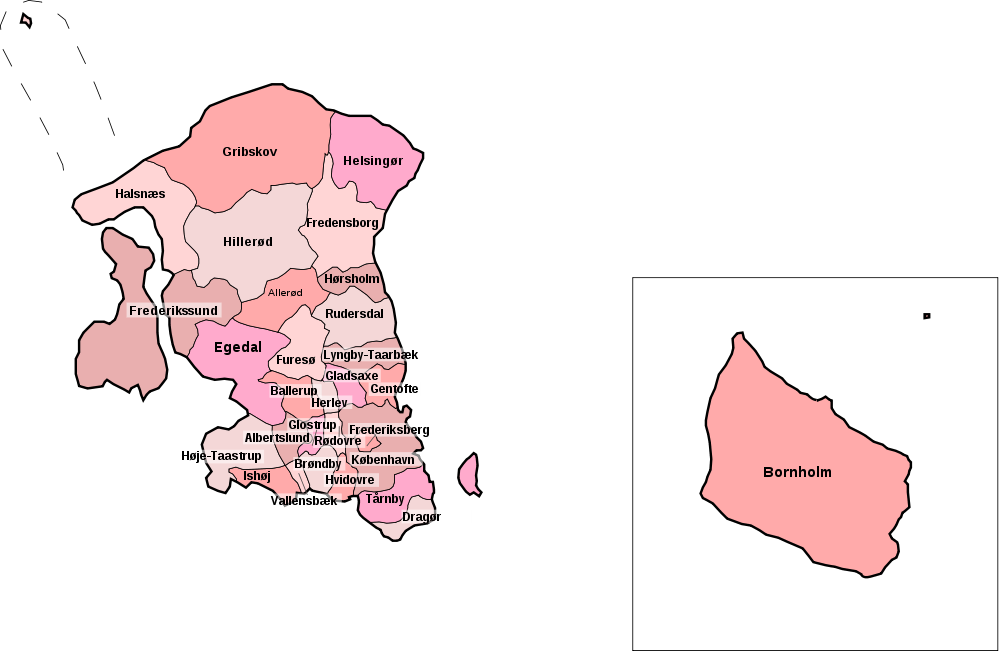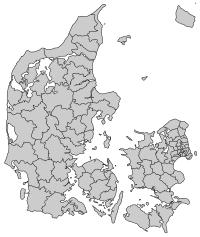Capital Region of Denmark
The Capital Region of Denmark (Danish: Region Hovedstaden, pronounced [ʁekiˈoˀn ˈhoːð̩ˌstæðˀn̩]) is the easternmost administrative region of Denmark, established on January 1, 2007 as part of the 2007 Danish Municipal Reform, which abolished the traditional counties (Danish plural: amter, singular: amt) and set up five regions. At the same time, smaller municipalities were merged into larger units, cutting the number of municipalities from 271 before 1 January 2006, when Ærø Municipality was created, to 98. The reform diminished the power of the regional level dramatically in favor of the local level and the central government in Copenhagen. The Capital Region has 29 municipalities. The regional council consists of 41 elected politicians. The chairman as of 1 January 2014 is Sophie Hæstorp Andersen. She is a member of the Social Democrats political party. The reform was implemented on January 1, 2007. The main task for the Danish regions are hospitals and healthcare. It is not to be confused with the Copenhagen Metropolitan Area nor with the Øresund Region. Unlike the counties (1970-2006) (Danish Amtskommune literally county municipality) the regions are not municipalities and are thus not allowed to have coat of arms, but only logotypes, and cannot "shuffle money around" from one area of expenditure to another area of expenditure, that is, use money for any other purpose than has been stated specifically, but must pay money not used back rather like departments or agencies of the central government. The regions do not levy any taxes but are financed only through block grants.
Capital Region of Denmark Region Hovedstaden | |
|---|---|
 Flag | |
 | |
| Country | Denmark |
| Largest city | Copenhagen |
| Capital | Hillerød |
| Municipalities | |
| Government | |
| • Chairman | Sophie Hæstorp Andersen (Social Democrats) |
| Area | |
| • Total | 2,568.29 km2 (991.62 sq mi) |
| Population (1 October 2019)[1] | |
| • Total | 1,848,989 |
| • Density | 720/km2 (1,900/sq mi) |
| Time zone | UTC+1 (CET) |
| • Summer (DST) | UTC+2 (CEST) |
| GDP(nominal)[2] | 2017 |
| - Total | €120 billion |
| - Per capita | €65,900 |
| HDI (2018) | 0.960[3] very high · 1st |
| Website | www.regionh.dk |
For population growth, see Regions of Denmark.
For information about the reform, see Municipalities of Denmark.
Municipalities of the regions can be accessed from the Municipalities of Denmark template at the bottom of the page.
Overview
The Capital Region of Denmark is one of five regions in Denmark and consists of the municipalities of Copenhagen and Frederiksberg, the former counties of Copenhagen and Frederiksborg, and the regional municipality of Bornholm. In Danish the name is Region Hovedstaden. It borders Zealand and Sweden's Skåne County via the Øresund Bridge.
Denmark's largest lake (Danish sø), Arresø, lies 43 kilometers (28 miles) northwest of Copenhagen. There are several other lakes, the deepest in Denmark being Furesø, 14.5 km (9 miles) northwest of Copenhagen, which is the namesake of Furesø Municipality. Among several forests the region also has Gribskov,[4] namesake of Gribskov Municipality. The forest park Dyrehaven is just north of Copenhagen (and east of Furesø) in Gentofte and Lyngby-Taarbæk.
Geologically the region lies in the northern part of Denmark which is rising because of post-glacial rebound, making lakes out of former inlets and bays, of which Arresø is one example, having extended in a northwesterly direction as a part of Brødemose Sund into Kattegat.[5] (The land is rising by 9 millimeters every year in Furuögrund, the northeastern part of Skellefteå Municipality, north of Kvarken.) Because of the mobility of the sand dunes, forests have been planted along the coast of Kattegat in the municipalities of Helsingør, Gribskov, and Halsnæs.
Without the remote island municipality Bornholm, located 150 km (93 mi) southeast of Copenhagen and 135 km (84 mi) directly east of Vordingborg Municipality (Møn) (across the Baltic Sea), and regarding only the land area of the 28 municipalities in and around Copenhagen, between 1,800 and 1,850 sq km (between 700 and 715 sq. mi.), 1,000 inhabitants per sq km will be reached in 2019 with a population as of 1 April 2019 at 1,800,076 persons, and 39,582 persons living on Bornholm.
For the purpose of the road and rail connection to Øresund Bridge land has been added to Amager, which has a tunnel connecting it with the artificial island Peberholm just south of Saltholm. The land area of east Denmark (east of the Great Belt strait) is approximately 9,622 sq km (year?) (3,715 sq mi), possibly slightly more with new land added because of housing projects in the north of Copenhagen Municipality and the bridge and tunnels including the Fehmarn Belt Fixed Link and other traffic infrastructure projects. A new Copenhagen-Ringsted Line came into operation 1 June 2019 to increase transport capacity and relieve congestion in Roskilde and the narrow 9-9.5 mile isthmus between Roskilde Fjord and Køge Bugt by moving international and national train traffic to the new train line and only keeping local and regional traffic.
Before 2007, a Danish Capital Region (Danish: Hovedstadsregionen) did exist, but it did not cover exactly the same area and did not have the same legal functions.
The primary function and largest expenditure, around 90% of the budget, of the Capital Region, as with all the regions of Denmark, is to own and operate the hospital and health service of the region.
In the east of Denmark there is one traffic region covered by Movia, which is owned by the Capital Region of Denmark and Region Zealand and 45 of the 46 municipalities. Because of its remote location Bornholm has its own traffic company, BAT, formerly, when Bornholm was a county, Bornholms Amts Trafikselskab.
Likewise, in the east of Denmark the two regions and 45 of the 46 municipalities make up one employment region, and Bornholm is its own employment region. Bornholm also performs other tasks normally performed by the regions in the rest of Denmark. The municipality of Bornholm is therefore called Bornholm Regional Municipality. In some respects the island forms a region of its own.
As Denmark is a unitary state, its "capital region" is not a capital district, but merely one among several regions of Denmark, that happens to contain the national capital.
The region does not include the Ertholmene archipelago which is situated to the northeast of Bornholm.
Economy
The Gross domestic product (GDP) of the region was 122.2 billion € in 2018, accounting for 40.6% of Denmarks economic output. GDP per capita adjusted for purchasing power was 50,000 € or 166% of the EU27 average in the same year. GDP per person employed was 130% of the EU27 average. The Capital Region is the wealthiest region in Denmark.[6]
Hospitals
The following hospitals are managed by the Capital Region of Denmark:
- Amager Hospital on the island of Amager, Copenhagen
- Bispebjerg Hospital in Copenhagen
- Bornholms Hospital on the island of Bornholm
- Frederiksberg Hospital in Frederiksberg
- Gentofte Hospital in Gentofte
- Glostrup Hospital in Glostrup
- Herlev Hospital in Herlev
- Hvidovre Hospital in Hvidovre
- Nordsjællands Hospital in Esbønderup, Frederikssund, Hillerød, Elsinore, and Hørsholm
- Region Hovedstadens Psykiatri – psychiatric hospital with many centers around the region
- Rigshospitalet in Copenhagen
- Sct. Hans Hospital in Roskilde
Municipalities of Region Hovedstaden

There are 29 municipalities in the Capital Region of Denmark.
- Copenhagen
- Frederiksberg
- Albertslund
- Allerød
- Ballerup
- Bornholm
- Brøndby
- Dragør
- Egedal
- Fredensborg
- Frederikssund
- Furesø
- Gentofte
- Gladsaxe
- Glostrup
- Gribskov
- Halsnæs
- Herlev
- Hillerød
- Hørsholm
- Høje-Taastrup
- Hvidovre
- Ishøj
- Lyngby-Taarbæk
- Rudersdal
- Rødovre
- Tårnby
- Vallensbæk
See also
References
- FOLK1: Population quarterly database from Statistics Denmark (in Danish)
- https://ec.europa.eu/eurostat/documents/2995521/9618249/1-26022019-AP-EN.pdf/f765d183-c3d2-4e2f-9256-cc6665909c80
- "Sub-national HDI - Area Database - Global Data Lab". hdi.globaldatalab.org. Retrieved 2018-09-13.
- 401 Gribskov Retrieved 20 January 2018
- Den Store Danske Encyklopædi, article:Danmark, volume 4, page 542, illustration Landskabets dannelse
- "Regional GDP per capita ranged from 30% to 263% of the EU average in 2018". Eurostat.
External links
![]()
- Official website (in English)

.svg.png)